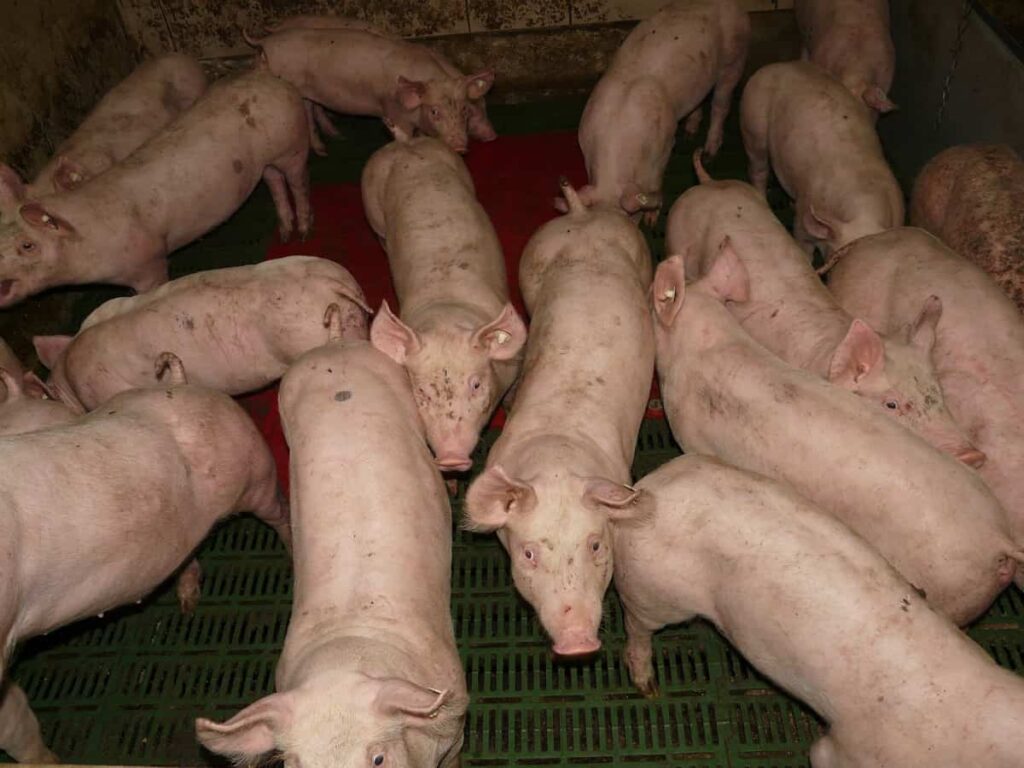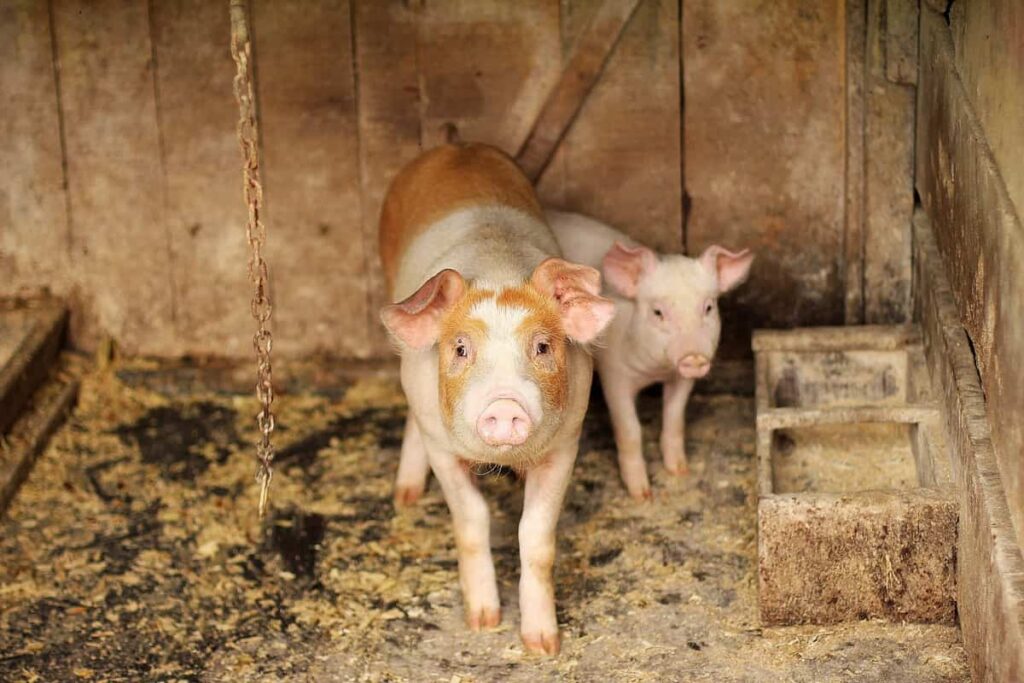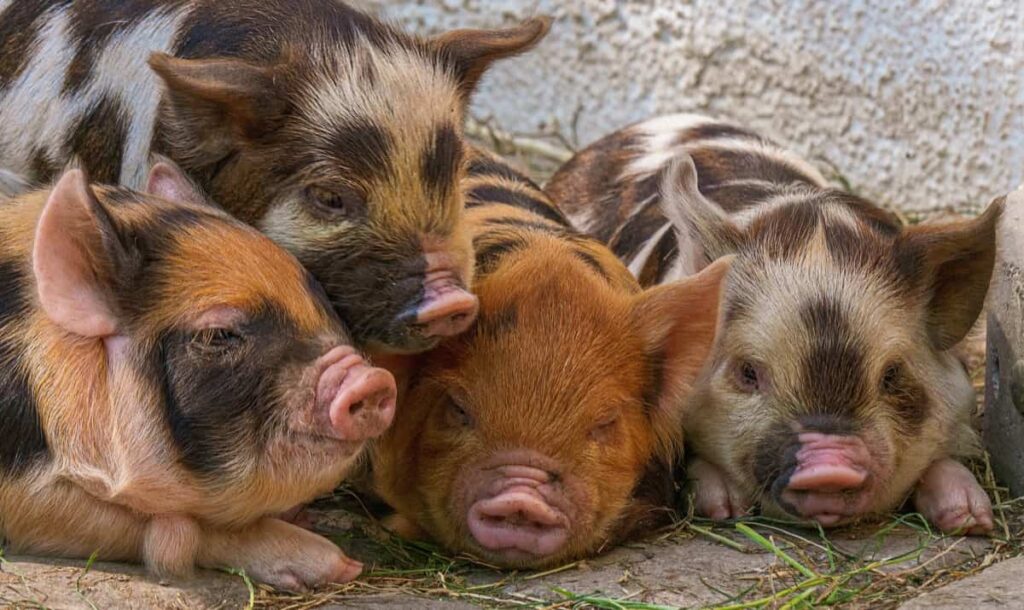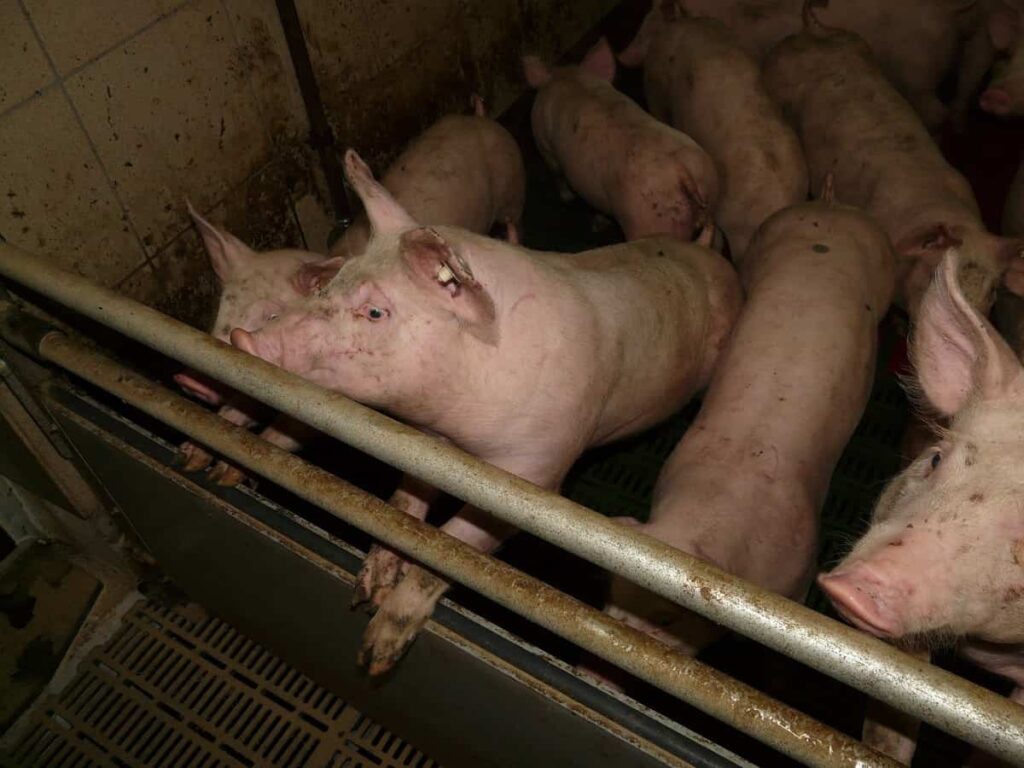Taking care of your piggy in the winter is essential. Here are some tips and techniques on how to keep your pig healthy and happy during the winter:
- Make sure their enclosure is warm and cozy. A heated hut or pen will help keep them warm and comfortable.
- Feed them plenty of hay and fresh vegetables. A diet full of fresh food will help them stay healthy and strong during the cold months.
- Provide enough water in their enclosure. Pigs are known to be very thirsty animals, so ensure they have access to plenty of fresh water.
- Keep an eye on their weight. If your pig starts to gain weight, ensure they are eating enough and that their enclosure is warm enough. If their weight drops, they may need more food or a warmer enclosure to stay healthy during the cold season. The following blog post will go through pig care and winter management.

How to care for your Pigs in the frost
Caring for your pigs in the frost
Taking care of pigs in the frosty months is crucial to ensure their well-being. Here are a few tips and ideas on how to care for them during the cold months:
- Make sure they have plenty of hay and fresh water.
- Provide shelter from the cold weather and keep them warm if possible by providing a heated pen or barn.
- Feed them a healthy diet with hay, straw, and vegetables.
- Keep an eye on their health; if they seem to be struggling, bring them in for veterinary care as needed.
Cold temperature management for pigs
Pigs are hearty animals and can handle cold temperatures well, but there are certain things that you should keep in mind when managing cold temperatures for your pigs. One of the most essential things to remember is to provide them with appropriate shelter and insulation. Pigs need a warm environment to maintain their body temperature, and they will not be as productive if cold.
Therefore, ensure them a comfortable bed, hay, and an area to escape the cold weather. You can also use an electric fence or barn door to help keep them inside during cold weather. Another thing that you should consider is feeding them food that is specifically designed for cold temperatures.
In case you missed it: Contract Pig Farming in India: Companies, Agreement, Profits, How it Works and the Pros and Cons

This will help them stay warm and keep their energy levels high. Make sure to give them enough food to avoid becoming obese in winter, but don’t overfeed them, as this can lead to health problems. Make sure to take all of these precautions when managing cold temperatures for your pigs; they will be able to cope well without any issues.
What do you do with pigs in the winter?
If you are an owner of pigs in the winter, there are certain things that you need to do to keep them comfortable and healthy. First, ensure they have plenty of hay, straw, and fresh food. If they don’t have enough hay, they may start to eat their own manure, which can be harmful. You can also put a layer of straw on the floor of their pen so that they have something to scratch and sit on. Finally, if your pigs are kept outside in the cold weather, you’ll need to shelter them from the wind and snow. You can build them a barn or cover them with a tarp.
Kind of shelter pigs need in winter
Pigs need a shelter that is both warm and dry. In cold weather, they need a shelter that is just a little large or too small. The size of the shelter will depend on the size of the pig and the climate. For example, a small pig in a cold climate might need a shelter that is only 20 square feet, while a large pig in a cold climate might need a shelter that is 100 square feet. The shelter should be made out of materials that are light enough. The shelter should be easy to clean and have openings that let in fresh air and sunshine.
Keeping your pigs warm without electricity
If you live in colder climates/regions and want to keep your pigs warm without having to use electricity, there are a few things that you can do. One is to heat a large barn area with a stove or build an igloo out of straw bales. You can also create a heated pen by building several small pens out of wood or plastic and filling them with hay or straw. Finally, you can install a heated wall or floor system if you have the space. Whatever you choose, ensure that the area is well-ventilated so the pigs can breathe comfortably.
In case you missed it: Pig Farming Subsidy and Loan in India – A Full Guide

How do you keep your mini pigs warm outside?
When it comes to keeping your mini pigs warm outside, you have a few different options. One option is to buy a heated pen. These pens can cost anywhere from $30-$60 and come with either an electric or gas heating system. Make sure the pen you choose has a weatherproof cover, as exposure to the elements can harm your pigs.
Another option is to build a shelter out of PVC pipe. Cut two pieces of pipe about 18 inches long, fit them together at one end, and attach the other end to a sturdy post. Make sure to cut a hole in the top of the shelter for your pigs to enter and exit, and attach a cover made from heavy-duty plastic or vinyl to keep the weather out. Whatever you decide to do, ensure your mini pigs are warm and safe!
What temperature is too cold for mini pigs?
Pigs are adapted to various temperatures, but mini pigs, in particular, may be more susceptible to health risks if exposed to cold temperatures. Around 40 degrees Fahrenheit is the lower limit for most pigs, and anything below that can be harmful. Exposure to cold weather can cause respiratory problems, heart disease, and even death in very small pigs.
Can pigs survive freezing temperatures?
Pigs can survive freezing temperatures as long as they are properly prepared for the conditions. Pigs will be affected differently by chilling than other animals, so it is important to provide them with enough shelter, food, and water to maintain their body temperature and prevent frostbite. Pigs should be moved into a warm area as soon as possible after being brought outside in cold weather, and they should be given plenty of food and drink.
How do you prepare a pig for winter?
You can do a few things to prepare your pig for winter, but the most important thing is to ensure their shelter is ready. You can build them a sty in the barn or outbuilding or purchase a pre-made pig shelter. If you don’t have a sty or shelter, your pig will need access to hay, straw, and fresh water.
In case you missed it: How to Control Pests and Diseases in Tobacco Crop: Causes, Symptoms, Chemical, and Biological Management

You will also want to provide them with food and water troughs so they can easily access these items. Make sure their food is of the right consistency and heat it if necessary, so it doesn’t spoil. If you have room in your barn or outbuilding, you can also build a shelter made of straw bales or hay bales.
How do you take a pig’s temperature?
If you are thinking about taking your pig’s temperature, there are a few things you need to know. The best way to take a pig’s temperature is by using a rectal thermometer. Pigs have relatively thick skin, and the thermometer will not go through it as easily as it would in a human.
You should also ensure that the thermometer is clean and dry before use. To take the temperature of your pig, insert the thermometer into its rectum and wait 10-15 minutes for the reading to come back. You should immediately call your veterinarian if the reading is over 100 degrees Fahrenheit.
How to treat hypothermia in pigs?
Hypothermia is a common problem in pigs and can be life-threatening. Treatment depends on the severity of the condition. If the pig has mild hypothermia, you can provide warmth and shelter. If the pig has moderate to severe hypothermia, you will need to seek medical help. You can use a heating pad, warm water, or a warming blanket to treat mild hypothermia. To treat moderate to severe hypothermia, you must use heat sources such as a heating pad or electric blanket. You may also need to give the pig antibiotics if it is infected.
In case you missed it: Easy Homemade Fertilizer Recipes: Natural and Organic for Houseplants, Flowers, and Garden Plants

What temperature is too cold for piglets?
Piglets are designed to live in warmer climates, so they can become sick or even die if their environment is too cold. Pigs can tolerate temperatures down to around 40 degrees Fahrenheit, but anything below that will start to suffer. If you’re raising pigs indoors, keeping the temperature on the lower end of this range is important to protect them from the cold. If you’re raising pigs outdoors, it’s up to you what temperature you want them to live in. Generally speaking, temperatures around 60 degrees Fahrenheit are perfect for piglets.
Does a baby pig need a heat lamp?
Most people would say that a baby pig needs a heat lamp to keep it warm. Pigs can regulate their body temperature more effectively than other animals, so they don’t need as much heat as other animals to stay warm. While a pig might not need a heat lamp directly on its body, it will still need one nearby in order to keep them warm. If you have a pen with a heat lamp inside, placing the pig inside the pen and turning on the light is best.
The lowest temperature a pig can withstand
Pigs can withstand temperatures as low as 40 degrees Fahrenheit. Therefore, in cold climates, pigs are kept indoors during the winter months. Pigs kept outdoors in colder climates will typically be housed in a barn with a temperature of around 50 degrees Fahrenheit.
In case you missed it: Agricultural Business Plan: How to Start, and Profitable Ideas

Conclusion
Proper care and monitoring of your pigs in winter are very important for any pig farmer. With right pig farming business plan and hard work will bring you good profits in the commercial pig farming business.
- Crops Grown in Summer Season: Best Choices for Summer Gardening
- Organic Pest Control for Tomato Farming
- How to Maximize Sheep Farming Profit
- Broccoli Varieties: Choosing the Right Cultivars for Your Farm
- How to Raise Pigs in Your Own Backyard: A Comprehensive Guide
- Budget Friendly Sheep Shed Ideas: Cheap and Low-Cost Tips
- How Much Do Cattle Farmers Make: Revenue Streams in Cattle Farming
- Management Pests and Diseases in Your Cotton Field
- Sheep Farming Business Plan for Beginners
- Aquaponic Farming at Home: A Step-By-Step Guide
- Profitable Village Farming Business Ideas in 2024
- High-Yield Aquaculture: Fast-Growing Fish for Farming
- Effective Fish Pond Construction Techniques for Beginners
- Irrigation and Water Management in Pineapple Farming
- Blossom to Harvest: Mastering Flowering and Pollination in Papaya Farming
- Pig Fattening Essentials: From Selection to Sale for Beginners
- Raising Wagyu Cattle: A Complete Guide for Premium Beef Production
- Soil Types and Their Water Holding Capacity
- Optimizing Irrigation Schedules for Coconut Groves for Enhanced Yield
- Espresso Your Garden: Coffee Grounds for Healthier Acid-Loving Plants
- The Best Soil Mix for Snake Plants: How to Mix Your Own Snake Plant Soil
- Green Thumb Success: Expert Tips for Cultivating Greenhouse Beans All Year Round
- Bloom All Year Round: The Ultimate Guide to Indoor Hyacinth Care
- Eco-Friendly Gardening: How to Make Liquid Fertilizer from Kitchen Waste
- Ultimate Guide to Grow Anise in Pots: Explore Seed Propagation to Harvesting
- Guide to Raising Chester White Pigs: Discover Breed Facts to Growth Management
- Mastering the Elegance: The Ultimate Guide to Weeping Cherry Tree Care, Planting, and Maintenance
- Ultimate Guide to Planting Garlic in Grow Bags: Growing Strategies for Beginners
- How to Fix Spider Plant Leaf-Related Problems: Natural and Organic Remedies
- 10 Reasons Why Your Tulsi Plant is Shedding Leaves: Home Remedies and Solutions
- Optimizing Growth and Yield: The Advantages of Palm Bunch Ash Fertilizer
- Utilizing Neem Oil Extract as a Natural Pesticide for Hydrangea
- From Soil to Harvest: Various Ways in Which Farmers Can Use AI Tools
- Steps to Encourage and Induce Citrus Flowers: A Comprehensive Guide
- How to Fix Snake Plant Leaf-Related Issues: Natural and Organic Remedies
- Transform Your Garden into a Fragrant Oasis with Raat Ki Rani (Night Blooming Jasmine)
=
